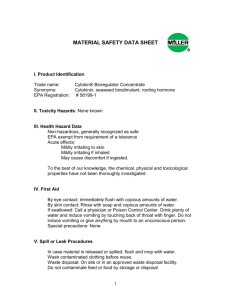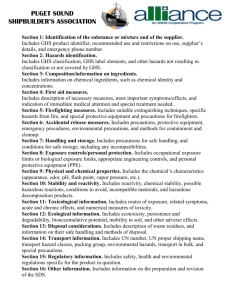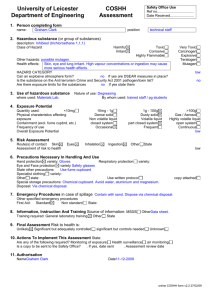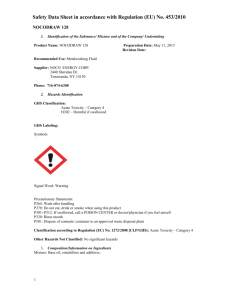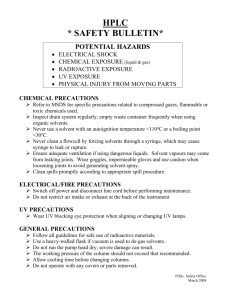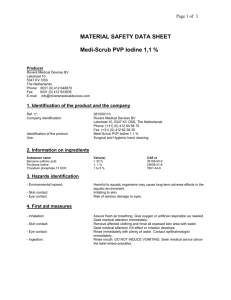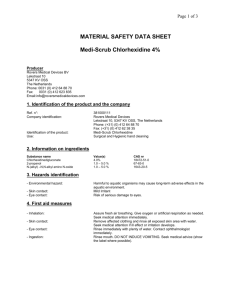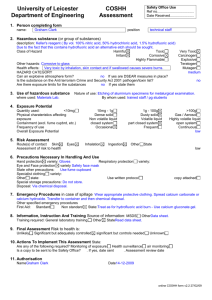Evaluation by Rapporteur Member State
advertisement
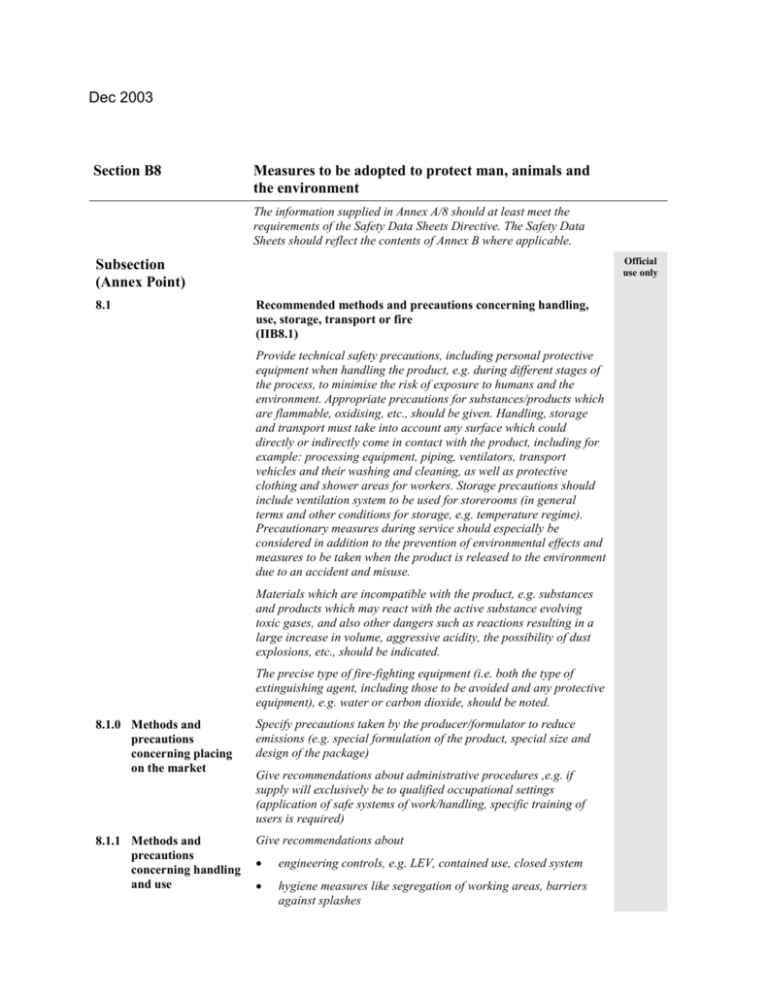
Dec 2003 Section B8 Measures to be adopted to protect man, animals and the environment The information supplied in Annex A/8 should at least meet the requirements of the Safety Data Sheets Directive. The Safety Data Sheets should reflect the contents of Annex B where applicable. Official use only Subsection (Annex Point) 8.1 Recommended methods and precautions concerning handling, use, storage, transport or fire (IIB8.1) Provide technical safety precautions, including personal protective equipment when handling the product, e.g. during different stages of the process, to minimise the risk of exposure to humans and the environment. Appropriate precautions for substances/products which are flammable, oxidising, etc., should be given. Handling, storage and transport must take into account any surface which could directly or indirectly come in contact with the product, including for example: processing equipment, piping, ventilators, transport vehicles and their washing and cleaning, as well as protective clothing and shower areas for workers. Storage precautions should include ventilation system to be used for storerooms (in general terms and other conditions for storage, e.g. temperature regime). Precautionary measures during service should especially be considered in addition to the prevention of environmental effects and measures to be taken when the product is released to the environment due to an accident and misuse. Materials which are incompatible with the product, e.g. substances and products which may react with the active substance evolving toxic gases, and also other dangers such as reactions resulting in a large increase in volume, aggressive acidity, the possibility of dust explosions, etc., should be indicated. The precise type of fire-fighting equipment (i.e. both the type of extinguishing agent, including those to be avoided and any protective equipment), e.g. water or carbon dioxide, should be noted. 8.1.0 Methods and precautions concerning placing on the market Specify precautions taken by the producer/formulator to reduce emissions (e.g. special formulation of the product, special size and design of the package) 8.1.1 Methods and precautions concerning handling and use Give recommendations about Give recommendations about administrative procedures ,e.g. if supply will exclusively be to qualified occupational settings (application of safe systems of work/handling, specific training of users is required) engineering controls, e.g. LEV, contained use, closed system hygiene measures like segregation of working areas, barriers against splashes Section B8 Measures to be adopted to protect man, animals and the environment protective gloves (tested by a certified institution, protection factor), respiratory protective equipment (type and where applicable dependence on the level of exposure), further PPE if necessary (work clothing) the protection of bystanders, the protection in case of secondary exposure precautionary measures against environmental exposure, e.g. appropriate use of control systems to avoid contamination of the surrounding environment, for example, via ventilation systems or drains 8.1.2 Methods and precautions concerning storage Give recommendations for the ventilation system in the store rooms, type of container, conditions for storage, any necessary temperature regime, give informations about regulations to be observed 8.1.3 Methods and precautions concerning transport Give information about precautionary measures during transport within and outside occupational settings (including international and national code numbers for transport, e.g. UN, if available) 8.1.4 Methods and precautions concerning fire Give recommendations about extinguishing agents and personal protective equipment and how to treat residues after the fire 8.2 Specific treatment in case of an accident, e.g. first-aid measures, antidotes, medical treatment if available; emergency measures to protect the environment (IIB8.2) Specific treatment in case of an accident, for example, first aid measures following accidental eye or skin contact, ingestion or inhalation, antidotes, medical treatment if available; emergency measures to protect the environment; in so far as not covered by paragraph A8.3 (data set for the active substance) [Ann. IIB, VIII.8.2.] Provide precise medical data regarding first aid, proven antidotes, and proven medical treatment. This should detail the effectiveness of first aid, suggested antidote doses, etc. and include full documentation of reference sources. The information here is intended for the purpose of immediate first-aid treatment. It is not intended to replace definitive diagnosis and treatment, which can only be undertaken by a qualified medical doctor. 8.2.1 Specific treatment in case of an accident, e.g. firstaid measures, antidotes, medical treatment if Measures and courses of action in response to different kinds of accident scenarios (e.g. threat of release of the biocidal product, the product is actually being released and release has already occurred) should be described. In addition actions to avert or stop release, minimise impacts of release, protect human life and property and recover the product and by-products should be indicated. Give recommendations concerning first-aid measures after accidental contact with eyes, skin, ingestion or inhalation Section B8 Measures to be adopted to protect man, animals and the environment available 8.2.2 Emergency measures to protect the environment Describe steps to be taken if the product is released or spilled. Give/refer additionally to personal protective equipment if necessary, labelling of waste containers and their composition. Specify appropriate procedures or means for cleaning 8.3 Procedures, if any, for cleaning application equipment (IIB8.3) The procedures should be such that the likelihood of accidental contamination of water or its sediments is minimised. Recommend procedures to minimize residual contamination. Give/refer to personal protective equipment if necessary 8.4 Identity of relevant combustion products in cases of fire (IIB8.4) It should be stated what gases are evolved, either by experiment or on the basis of structure, when the substance burns or when heated in the absence of air so that it simply decomposes, e.g. nitrogen oxides, phosgene or soot. Especially the identity of dangerous substances formed should be given (e.g. analysed according to the ISO standard 9122, Part 3, ISO 1993). Specify products arising from burning (excess of oxygen) or pyrolysis (no oxygen). Specify if this information derives from test. For experiments the burn-out factor (ratio of theoretical oxygen demand and ratio of generated CO2/CO) should be reported along with temperature profile of the process 8.5 Procedures for waste management of the biocidal product and its packaging and where relevant, treated waste material for industry, professional users and the general public (nonprofessional users), e.g. possibility of reuse or recycling, neutralisation, conditions for controlled discharge, and incineration (IIB8.5) Procedures for waste management of the biocidal product and its packaging for industry, professional users and the general public (non-professional users), for example, the possibility of re-use or recycling, neutralisation, conditions for controlled discharge, and incineration [Ann. IIB, VIII.8.5.] Product-type-specific guidance is given here. Information necessary for safe disposal must be given. If preliminary treatment of the waste is necessary, information about this must also be given. If any waste generated is classified as hazardous waste (e.g. according to Council Decision 94/904/EC 2 ), this has to be mentioned separately and appropriate handling according to the related legislation indicated. The possibility of recovery or recycling should be indicated for both normal uses of the substance and quantities involved in spills. A chemical or other disposal method for the product. Disposal methods for the waste generated when using the product (e.g. precipitates generated, instruments for spreading, residues treated with the product). Section B8 Measures to be adopted to protect man, animals and the environment Information must be given on how the package is to be emptied and cleaned and on the recycling or disposal method for empty packages. Recycling or disposal methods for the waste generated from a treated product, and in the processing of the treated product (e.g. shavings, cuttings or other waste from the treated product) and for treated products no longer in use (e.g. impregnated wood), if applicable. The guidance given for the corresponding data requirement for the active substance (paragraph A8.5) applies also here. When the product is applied to a system with water which is to be released into surface water with or without pre-treatment, as may be for product type 11 and 12, information on the necessary waste water treatment methods and times and/or the on minimum dilution for the active substance in waste water in order to assure a sufficient decree of degradation or dilution before being released into a water course to protect aquatic organisms from harmful effects. Recycling or disposal methods for the waste generated from a treated material (e.g. for chips from metal-cutting where the product is used), and in the processing of the possible treated material (e.g. waste from treated paper pulp or porous sand strata for product type 12) and for treated material or treated process water or metal working fluid no longer used, if applicable. Specify procedures for industrial/professional and where relevant for general public areas. Then specify the possibilities of reuse, recycling, neutralisation and disposal 8.6 Possibility of destruction or decontamination following release in or on the following: (a) Air; (b) Water, including drinking water; (c) Soil (IIB8.6) 8.6.1 Possibility of destruction or decontamination following release in the air 8.6.2 Possibility of destruction or decontamination following release in water, including drinking water Prevention of health and environmental effects and measures to be taken when the product is released to the environment due to an accident or misuse. Provide details of measures necessary to quickly limit the consequences of accidental release to the environment, and to decontaminate areas affected by the accidental release. These may include neutralisation, destruction and removal procedures. Give information about e.g. efficacy of adsorptive materials for biocidal gases after treatment of storage buildings Section B8 Measures to be adopted to protect man, animals and the environment 8.6.3 Possibility of destruction or decontamination following release in or on soil Give information about e.g. efficacy of soil decontamination processes 8.7 Observations on undesirable or unintended side-effects, e.g. on beneficial and other non-target organisms (IIB8.7) E.g. unnecessary suffering and pain for vertebrates or effects on wildlife. Additionally, observations such as on adverse reaction to fastenings and fittings used in wood following the application of a wood preservative. It should also be reported if the substance is anticipated to have adverse effects on the air compartment, for example, which may contribute to the depletion of ozone layer, tropospheric ozone building, acidification, warming the atmosphere or degrading air quality. Give information about e.g. secondary poisoning of carnivores feeding on poisoned prey (owls, buzzards); poisoning of roosting bats 8.8 Specify any repellents or poison control measures included in the preparation that are present to prevent action against non-target organisms (IIB8.8) Evaluation by Competent Authorities Use separate "evaluation boxes" to provide transparency as to the comments and views submitted EVALUATION BY RAPPORTEUR MEMBER STATE Date Materials and methods Results and discussion Conclusion Reliability Usually 0, i.e. not applicable, if the section contains no study or test data Acceptability Remarks COMMENTS FROM ... Date Give date of comments submitted Results and discussion Discuss additional relevant discrepancies referring to the (sub)heading numbers and to applicant’s summary and conclusion. Discuss if deviating from view of rapporteur member state Conclusion Discuss if deviating from view of rapporteur member state Reliability Discuss if deviating from view of rapporteur member state Acceptability Discuss if deviating from view of rapporteur member state Remarks
